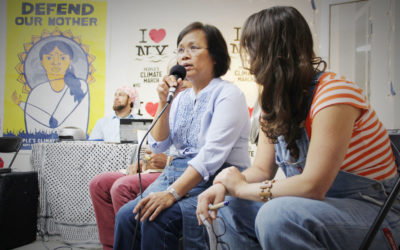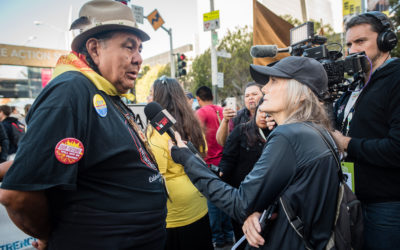Land
For Indigenous Peoples, the Earth is the Sacred Mother. The Earth has natural limits and a rhythm. The Earth holds the life we know. The Earth seeks balance with water, air and fire. We are made of Earth.
One emerging example…
includes so-called soil remediation projects in New Mexico where communities impacted by fracking are given “green jobs” to spread contaminated soil out on large tracts of lands until it is “cleaned” over time. These projects count as an offset and benefit the extraction industries.
Carbon Capture and Storage
(also Carbon Capture Use and Storage and Carbon Capture and Sequestration)
The idea behind CCS is to permanently extract carbon dioxide (CO2) from pollution at fossil fuel burning facilities, compress it into a liquid and pump it underground so that it would not contribute to carbon dioxide in the atmosphere. There are several problems with this idea. First, and most importantly, this does not stop the environmental destruction that happens when extracting fossil fuels from the ground, nor does it stop the negative impacts of communities living near these sites. In fact, it creates a lock-in dependency that demands more extraction. Second, there are no guarantees that the CO2 will not leak out.
CCS has been used for more than 40 years for Enhanced Oil Recovery (EOR). EOR involves pumping pressurized CO2 into old underground oil reservoirs to recover less accessible oil. Oil companies in the US continue to push for CCS because it allows continued extracting and they get a tax break. In the US, fossil fuel corporations using EOR receive a tax credit, 45Q. The tax credit covers generally 15 percent of qualified costs of EOR, but how this cost is calculated is questionable.
“Violence against the land is direct violence against our bodies”
– Pueblo Action Alliance organizers stating a phrase frequently used by organizers against extractives in their area at the indigenous pilot training. Chicago, July 2019.
Reducing Emissions from Deforestation and forest Degradation (REDD) is a conservation program used by multiple institutions.
Dangers of the CO2 leaking are rarely discussed. The captured carbon could leak out for many reasons, including faulty construction, earthquakes or other underground movements. At such high concentrations, leaked CO2 is toxic.
Carbon pricing programs continue to point to CCS as carbon neutral and are used to offset pollution. For example, the California Air Resource Board (CARB) oversees the California Global Warming Solutions Act of 2006 (AB 32) which launched the California cap and trade program. The program began its Low Carbon Fuel Standard (LCFS) program in April 2009, setting a baseline of 1990 pollution levels by the year 2020. In July 2017, AB 398 included amendments to AB 32, expanding the cap and trade and LCFS programs to 2030 at 40 percent reduction against the baseline. In 2018, CARB adopted further standards to sell CCS credits under the LCFS.
Reducing Emissions from Deforestation and forest Degradation (REDD)
Reducing Emissions from Deforestation and forest Degradation (REDD) is a conservation program used by multiple institutions being implemented internationally but also domestic – within the US and Canada – but under different terminology. Forest offsets place a price on CO2 that the trees are estimated to absorb. These are calculated into credits and sold to polluters who want to offset their pollution on the voluntary carbon markets. This way large polluting corporations can pollute above the cap and subtract the total pollution from the credits they buy through forest offset programs.
Putting a price on forests and trees comes inserted in a process of privatization (property rights), commodification (creating a tradable commodity) and financialization (trading money, risks and associated financial products) of nature and its capacities. These commodities are abstract or intangible. For example, it is not only the wood or fruits from a tree that are bought and sold, but rather the capacity of this tree to absorb carbon dioxide that is given a monetary value. In this way, a new commodity is created, based on real material nature that can also be traded on the markets to ultimately support the profits of polluting industries.
Often, third party consultants and conservation NGOs are paid to convince communities that they will receive money for a long period of time for not cutting down their trees and forests. Indeed, the majority of the international funding used for REDD has been used to pay mid-level bureaucrats and third-party consultants to set up programs. Research has shown that communities are often not consulted or are tricked into signing contracts, some contracts extending 90 years +. Other communities have given up their rights to collect medicinal herbs and other significant cultural ties to the forests after signing contacts. Importantly, the corporations and conservation groups are covered under insurance policies in case of fire, but the communities are not.
Although REDD+ is not yet based within a UN-backed emissions trading market, it does not alter the basic direction of the scheme for which it was designed. REDD is now called many different names and it is important to ask questions when words like “nature based solutions”, “carbon neutral” or “forests” are involved.
Indeed, the majority of the international funding used for REDD has been used to pay mid-level bureaucrats and third-party consultants to set up programs.
In addition, there are several bilateral and multilateral agreements between countries that are implementing REDD+ projects. Further, the voluntary carbon markets are already trading credits from forest offset projects. Also, the Green Climate Fund (GCF) actively funds REDD+ projects. Green bonds are another way REDD+ is funded. The question should not be, whether REDD+ will be included in an international offset market, but rather, how are REDD+, forest offsets, Nature Based Solutions and related-activities being designed to commodify forest carbon and how is this impacting land rights, property rights, sustainable agricultural practices and Indigenous Peoples? These programs already have dire impacts on the relationships between power and resistance in communities.

Land: Responses and Resistance
Aiy-ye-kwee, Nek-new Shannon Albers. Ser-per mey’-woh-mech-ok. by Shannon Albers, member of the Yurok Tribe Hello! My name is Shannon Albers. I come from the Yurok Village of Ser-per. I am an enrolled member of the Yurok Tribe of Northern California, US. I am twenty...
Workshop Sessions
Popular education activity guides for workshops and courses
Mind Mapping
Time: 40-60 minutes Learning Style: Large group activity, visual and oral.Objective: The idea is to create a visual Conflict Map and use it to look for places to intervene. This activity will be the first to gently push us towards starting to look for ways to build...
Jargon Busting Game
Time: n/a Learning Style: Movement, group-building, ice breaking, oral, auditory and building confidence in group feedbackObjective: There are many acronyms in climate change and carbon pricing lingo. This workshop aims to break these down into understandable...
Press Conference Role Play
Time: 30 - 60 minutes Learning Style: Oral, humor, group-buildingObjective: Participants practice discourse and narratives on carbon pricing through a mock press conference. The objective is to create a safe space to practice and to work together to speak truth to...





